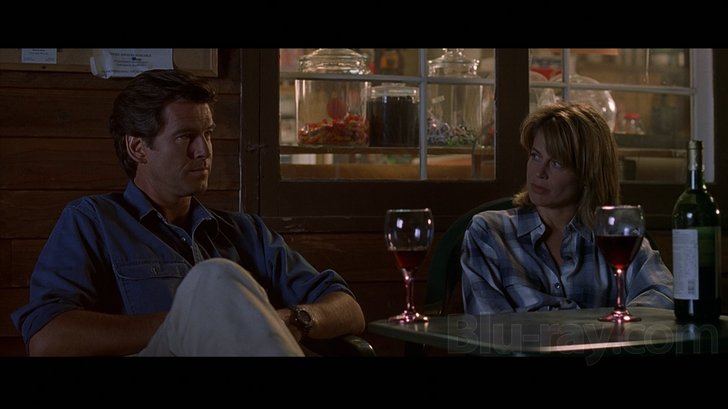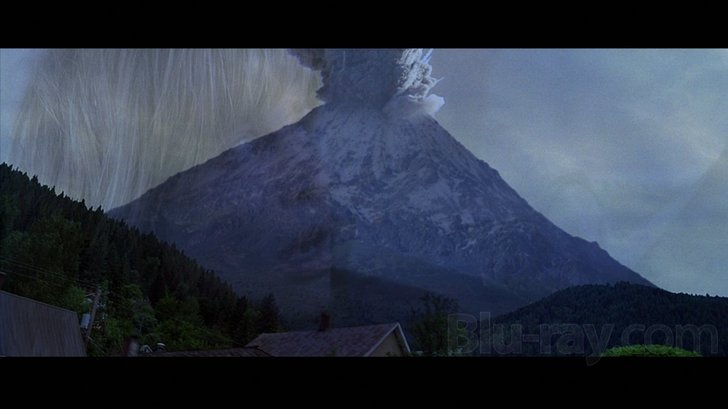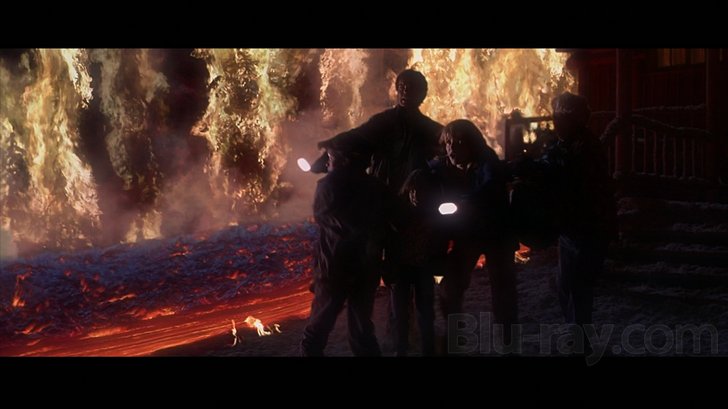Dante's Peak Blu-ray Movie
HomeDante's Peak Blu-ray Movie 
Universal Studios | 1997 | 108 min | Rated PG-13 | Jul 26, 2011Movie rating
6.6 | / 10 |
Blu-ray rating
| Users | 4.1 | |
| Reviewer | 3.5 | |
| Overall | 3.8 |
Overview
Dante's Peak (1997)
When unusual seismic activity is detected in the town of Dante's Peak, volcanologist is called in to investigate. He is certain that a long-dormant volcano is set to erupt and destroy the town.
Starring: Pierce Brosnan, Linda Hamilton, Jamie Renée Smith, Jeremy Foley, Elizabeth HoffmanDirector: Roger Donaldson
| Thriller | Uncertain |
| Action | Uncertain |
| Adventure | Uncertain |
Specifications
Video
Video codec: VC-1
Video resolution: 1080p
Aspect ratio: 2.36:1
Original aspect ratio: 2.39:1
Audio
English: DTS-HD Master Audio 5.1 (48kHz, 24-bit)
Spanish: DTS 2.0
French: DTS 5.1
Subtitles
English SDH, French, Spanish
Discs
25GB Blu-ray Disc
Single disc (1 BD)
BD-Live
D-Box
Mobile features
Playback
Region free
Review
Rating summary
| Movie | 3.0 | |
| Video | 3.0 | |
| Audio | 4.0 | |
| Extras | 4.0 | |
| Overall | 3.5 |
Dante's Peak Blu-ray Movie Review
Jaws with Rocks
Reviewed by Michael Reuben August 7, 2011With the copycat habit that studios can't seem to shake, 1997 saw two volcano-themed films hurtling toward the box office, Universal's Dante's Peak and Fox's Volcano. Universal won the race, and Fox had to hold its film until the following spring, hoping that a few extra months would make audiences forget they'd just seen a volcano wreak havoc on the screen. The strategy didn't work, and Volcano did weaker box office (though neither was a blockbuster). What struck me at the time, though, is how different the two films are, even though both derive from the same "high concept". Volcano plays like a classic Seventies disaster film, in which an unstoppable force bursts into a space where it doesn't belong (in this case, Los Angeles), because humanity thinks it has complete dominance and control over the venue (hah!). Dante's Peak is more like Jaws. It's set in a peaceful locale on the edge of an untamed natural domain with which humanity has coexisted for years in a sort of detente -- until one day some atypical incidents bring experts to town inquiring whether the truce has been broken. As experts often do, they disagree, and the local business owners fret about losing tourists and investors. By the time the problem has become too big to ignore -- one might call it the "we're going to need a bigger boat" moment -- it's too late.

Harry Dalton (Pierce Brosnan) is a volcanologist with the U.S. Geological Survey. While on vacation (which, for a volcanologist, means an opportunity to stay home), Harry is called back by his boss, Paul Dreyfus (Charles Hallahan), to investigate odd readings from Dante's Peak, a dormant volcano in Washington State perched over a town of the same name at its base. Harry and Dreyfus assume it's another false alarm, because that's what it usually is. We know it isn't, because otherwise there would be no movie. Harry has "issues" that will undercut his credibility when, shortly after arriving in Dante's Peak, he concludes there's danger underfoot. Four years earlier, his fiancée, Marianne (Walker Brandt), was killed while the two of them were on assignment studying an eruption in Colombia and delayed their departure too long. Now Harry has a reputation for being trigger happy in calling for alerts. As it happens, a lot of people in Dante's Peak don't want to hear bad news. The town has just been named second best place to live in America (population under 20,000) by a major magazine, and the award has attracted significant commercial investment. But then again, there are those two parboiled skinny dippers found in a hot spring shortly after Harry arrives, and dead bodies do seem cause for concern. Harry persuades the town mayor, Rachel Wando (Linda Hamilton), to call a city council meeting, but his boss, Dreyfus, suddenly appears and tells the council that they need do nothing. He and his whole team (Grant Heslov, Kirk Trutner, Arabella Field and Tzi Ma) have arrived to check out their volcano from top to bottom and render a complete scientific report, which Dreyfus is sure will be favorable. Geological jargon flies, gizmos are deployed and readouts are studied. In his off-hours, Harry gets close to Mayor Rachel and her two adorable children, Graham (Jeremy Foley) and Lauren (Jamie Renée Smith), so that he'll have a personal stake in the chaos when the mountain eventually blows. And yes, the screenplay by Leslie Bohem (Nowhere to Run) really is that obvious in its plot machinery, right down to the absent father who abandoned Rachel and the children six years earlier and hasn't been heard from since (thereby leaving Rachel conveniently available) and the stubborn Grandma Ruth (Elizabeth Hoffman), Rachel's mother-in-law, who refuses to leave her home high on the slopes of Dante's Peak (thereby providing a reason for Harry and the Wando family to race up the mountain when everyone else is fleeing to safety). But how can one complain about plot fabrications in a genre that depends upon them so heavily? Have you ever noticed what perfect timing these unthinking, non-human adversaries have in movies? In Jaws the shark manages to swim into the pond at the exact moment when everyone is distracted by the kids' prank with the fake dorsal fin. (How did it know?) In Dante's Peak, the mountain never does anything major unless it can accomplish something vicious and aggressive, like frying the two swimmers, or catching one of the geologists in a particularly precarious position during a major tremor so that he falls and is buried under rubble, or, best of all, holding off the big eruption until the entire population of Dante's Peak is gathered together under one roof for a town meeting so that the resulting stampede and panicked exit causes maximum chaos. For all the time devoted to discussing emergency plans and orderly evacuation, the evil-eyed mountain knows enough to pick just the right moment to create one giant traffic jam, the better to up the body count when it shatters the town and collapses the highway. But that's what you came to see, right? The director, Roger Donaldson (The Bank Job), does an effective job of acquainting viewers with the town and its structures in the first half of the film so that, when it all comes tumbling down, you feel like something familiar is being destroyed. And Donaldson is also inventive in his visual exploration of the manifold dangers that a volcanic eruption creates, including the familiar lava, the burning rocks that land like bombs, the thick ash that chokes machinery, or the chemical reactions that so radically alter the composition of a lake that the water turns to acid. A former geology student who briefly considered a career in the field, Donaldson insisted on script revisions to make the hazards faced by Harry Dalton et al. as realistic as possible. Still, one wishes Donaldson had gone a little further. It's all well and good to have Harry utter the phrase "pyroclastic cloud" as a dense, menacing fog from the mountain pursues him, Rachel and the children, but I suspect most viewers will share my reaction when I first saw the film, which was: "Huh? What's that?" Nothing further is explained in the film, and one shouldn't have to consult Wikipedia (or its 1997 equivalent) to understand one of the story's direst threats. (For the record, the usual term is "pyroclastic flow", and it refers to a current of gas and rock expelled by a volcano at a temperature of up to 1000º C and moving at up to 450mph.) For my taste, the film runs too long. The last ten minutes or so feel anticlimactic, because the hazards, while real, can't live up to the scale of what's preceded them. (I'm being deliberately vague for the sake of first-time viewers.) Still, Dante's Peak has the one essential element for a film that wants to thrill audiences, and that's credible lead performances. If the people who are supposed to be in jeopardy aren't afraid, the audience won't be either. Pierce Brosnan and Linda Hamilton are first-rate actors, and they do as much as the effects wizards to sell the elaborate volcano tableaus, some of which look dated but most of which hold up quite well by contemporary standards. They're still the best reason to see Dante's Peak.
Dante's Peak Blu-ray Movie, Video Quality 

Dante's Peak was Donaldson's second collaboration with cinematographer Andrzej Bartkowiak (the first was Species). Bartkowiak's breakthrough work in America was with Sidney Lumet, who famously hated showy camera work, which may be why Bartkowiak doesn't seem to have a signature style. He adapts to the material. Dante's Peak begins and end with major sequences that are murky and gray -- almost to the point of being black-and-white -- from blizzards of volcanic ash. For the sake of continuity and blending, the "normal" sequences in between can't be overly colorful or eye-popping, and they never have been. However, levels of black and white must be accurately maintained, or the "ash" scenes risk degenerating into shadowy muck. The 1080p, VC-1-encoded Blu-ray from Universal successfully reproduces the correct levels of black and white and gets the colors right in between, but it's less satisfactory in other respects. Detail suffers noticeably whenever we move away from objects in the foreground. The effect is most obvious in long shots with numerous separate items in the background, such as the outdoor crowd that Rachel addresses just after Harry arrives in town; the individual persons are vaguely outlined and sometimes blur into one another, almost as if this were an image on DVD, not Blu-ray. The same effect can be observed when Harry is driving into town and people are visible down the street, and it's also evident when Harry and Rachel subsequently drive up the mountain -- the trees around them don't reveal the detailed leaf patterns that one expects to see in a film of this vintage and budget. I cite these examples, because they occur in broad daylight, where shadows and sufficient lighting should not be an issue, and because they occur early enough in the film that interference from volcanic activity (or, to be precise, the special effects used to simulate it) cannot be the cause. Nor is this phenomenon attributable to focal issues. The objects are in focus, but the transfer isn't sharp enough to capture them. The situation appears to improve in the latter parts of the film, but that may simply be a function of unfamiliarity. We all know what crowds and forests look like, which means we know when they don't look right. But most of us can't make similar judgments about volcano craters, lava flows, ash storms or various other manifestations of the disaster depicted in Dante's Peak. If detail is similarly lacking in long shots, how would we know? This does not appear to me to be a case where DNR or other digital filtering was applied, because the usual signs of such filtering are absent; there were no motion artifacts, and faces in close-up looked natural and detailed. It's more likely that the original image harvest was less than it should have been. Maybe someday it'll be redone. In the meantime this version is watchable, though by no means the best that Blu-ray can provide. Addendum on Aug. 10, 2011: At least one viewer has reported seeing the kind of haloing around objects that is the telltale sign of artificial sharpening applied to make an image appear more detailed than it really is. The common term for this phenomenon is "edge enhancement", although it's a term I try to avoid, since it's often used loosely to describe a host of disparate phenomena. Since such sharpening has often been applied to precisely the kind of situations I described above, it is entirely possible that it has been applied to some or all of the Blu-ray of Dante's Peak. However, I myself did not notice any haloing, on a 72" screen from which I sit no more than 12 feet away. Still, different eyes see different things on different systems, and video sharpening tools are too closely associated with the issues I did notice to ignore the observation.
Dante's Peak Blu-ray Movie, Audio Quality 

Fortunately, there's nothing to fault in the DTS lossless presentation of Dante's Peak's soundtrack, which does full justice to the rumbles, crashes, explosions and all-around mayhem of the volcanic eruption and associated earthquakes, structural collapses, fires and lava flows. Both the rear channels and the subwoofer get a workout during these sequences, although you won't hear much from them during the long build-up that consists mostly of dialogue and a hammily portentous score by John Frizzell (with theme by James Newton Howard).
Dante's Peak Blu-ray Movie, Special Features and Extras 

It's my understanding that the Blu-ray's main supplements are identical to those on the previously released HD DVD, which I never saw. But the supplements are truly "vintage" in the sense that they date back to the 1997 "Signature Series" laserdisc set (remember those?). In the various editions of Dante's Peak since then, some supplements from that set have fallen by the wayside, including storyboards, photographs, the shooting script, advertising materials and an isolated musical score that was available as an alternate track to the documentary entitled "Getting Close to the Show". (And no, my set isn't for sale.)
- Commentary with Director Roger Donaldson and Production Designer Dennis Washington: The director and his production designer focus heavily on technical details, noting which scenes were locations and which were sets and distinguishing between practical effects, models and CG work. Both are effusive in their praise for the cast's willingness to tolerate the difficult conditions of the shoot, which often required working while coated with artificially created rain, mud and/or volcanic ash.
- Getting Close to the Show: The Making of Dante's Peak (SD; 1.33:1; 1:02:16): This detailed, behind-the-scenes documentary, written, produced and directed by Joseph "J.M." Kenny, is the kind of in-depth production that Universal used to create for its laserdisc series and rarely does today. It features lengthy interviews with Donaldson, producers Ilona Hertzberg and Gale Anne Hurd, stunt coordinator R.A. Rondell, production designer Washington, practical effects supervisor Roy Arbogast and visual effects supervisor Pat McClung. Brosnan and Hamilton are also interviewed. Substantial footage from both the location shoot and the effects photography is included. At one point Donaldson turns to the camera and laments that they're showing viewers too much about how the illusions are created; that philosophy seems to have taken over today's making-of documentaries, which reveal considerably less.
- Theatrical Trailer (SD; 1.33:1; 1:19): More a teaser than a trailer.
- MyScenes.
- pocketBLU™.
- D-BOX™ Motion Enabled.
- BD-Live.
Dante's Peak Blu-ray Movie, Overall Score and Recommendation 

Like most big studio pictures of the last twenty years or so, Dante's Peak is a "B" film with an "A" budget and cast. Massive craft and expense were poured into a telling a story that, for my money, could have been just as effectively told in a cheesy, low-budget thriller. (The big-budget version is pretty cheesy anyway, despite its scientific pretensions.) My own preference is for Volcano, which doesn't take itself as seriously and manages to inject a degree of wit into the unlikely juxtaposition of lava flows with the streets of L.A. Still, Dante's Peak has its moments, mostly courtesy of Brosnan and Hamilton. My only hesitation about recommending the Blu-ray is the weakness of the transfer. If you already have a previous version, I suggest renting the Blu-ray before buying.
Similar titles
Similar titles you might also like

Daylight
1996

Vertical Limit
2000

Poseidon 4K
Limited Edition
2006

Twister 4K
1996

The Perfect Storm
2000

The Day After Tomorrow
2004

The Colony
2013

The Runner
2015

The Poseidon Adventure
2005

Flight of the Phoenix
2004

Babylon A.D.
2008

Speed 2: Cruise Control
1997

Executive Decision
1996

Stealth
2005

Category 7: The End of the World
2005

Vice
2015

Into the Storm
2014

Terminator 3: Rise of the Machines
1080p Corrected Version
2003

13 Minutes
2021

Momentum
2015


